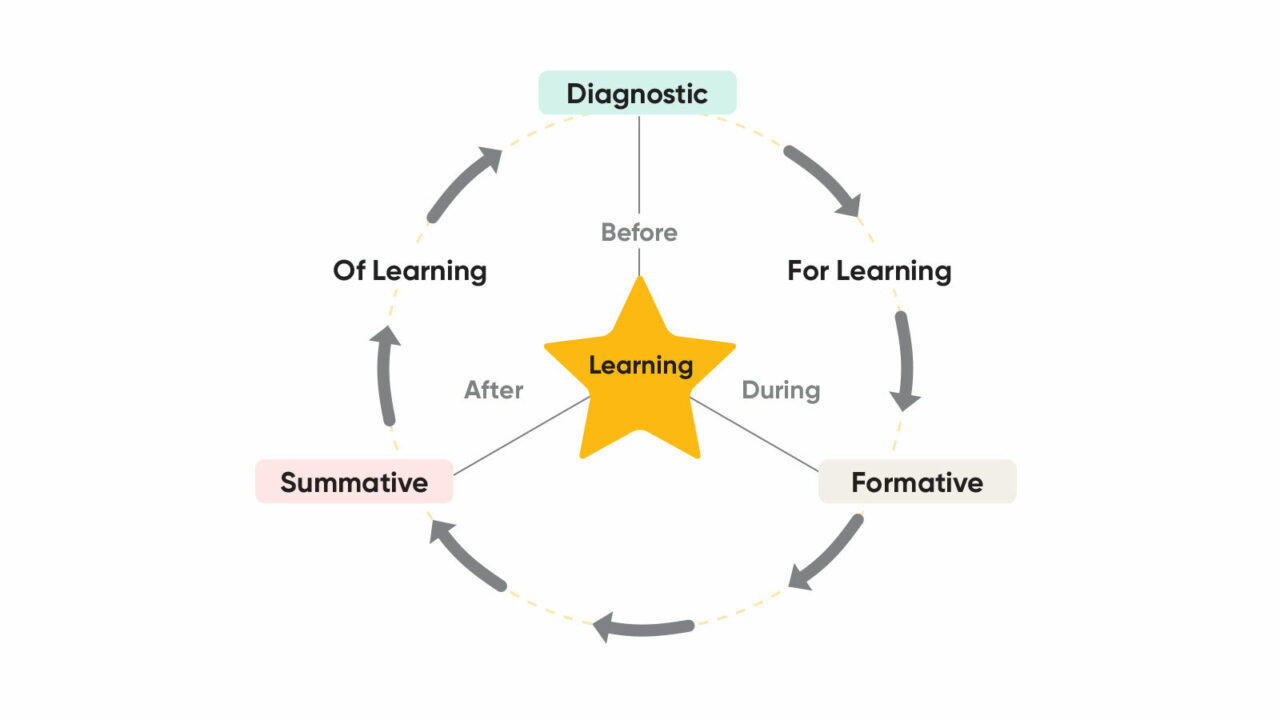
Math is often discussed as a subject that is straightforward to assess. Concepts seem to build naturally on each other, such as the progression from whole numbers to fractions to mixed numbers. However, the reality is that math assessment is complicated. Even supposedly straightforward progressions have quite a few wrinkles. Fractions are usually considered less advanced than mixed numbers, but is the fraction 105/70 really less advanced than the mixed number 1½? Where do decimals and negative numbers fit into the mix?
An important component of any educational assessment system is knowing where to begin the assessment process. This is where the idea of assessing to diagnose comes in. In particular, if a student is underperforming against a well-defined set of expectations, it is helpful to understand this as early as possible. Once we know which students are in need, we can further assess the deeper underlying causes of their challenges. When timed properly, students can receive supports that have maximum impact.
The Definition of Diagnostic Math Assessment
Diagnostic math assessment is not clearly or consistently defined in the literature. For simplicity, we will characterize it as an assessment that happens before learning occurs to measure what students know and can do. In education, diagnosis focuses on the knowledge and skills related to impending instruction. So, diagnostic assessment is used to assess prerequisite skills needed to engage with the learning to follow so that the teacher can determine what to teach during instruction.
Assessments can vary in terms of their diagnostic function, so it is probably more constructive to discuss diagnostic assessment as a process rather than a specific assessment. No matter how the assessment is designed, diagnostic assessment plays a role where it provides information about students’ mastery of relevant prior knowledge and skills as well as preconceptions or misconceptions about the material (Csapó & Molnár, 2019).
Initially, at a higher level, a diagnosis may only identify students who are struggling with math content. This may lead to a specific test (or possibly a battery of tests) administered at the beginning of the year to a subset of students who are experiencing these challenges. A more specialized diagnostic assessment is then used to drill down and measure finer constructs, uncovering specific issues that a student is struggling with in math.
To avoid confusion with other forms of assessment, we will limit our definition of diagnostic by focusing on two key attributes around timing and purpose.
- Timing: Diagnostic assessments come before learning has begun.
- Purpose: Diagnostic assessments determine how much prerequisite knowledge or skills students have about upcoming content.
In other words, diagnostic assessment is an assessment of skills in preparation for teaching yet to come.
The Difference Between Diagnostic, Formative, and Summative Assessments in Math
To see how diagnostic assessment fits into a bigger picture, we describe an assessment system as having three broad types: diagnostic, formative, and summative (see image below). There are other terms given to assessments, but they all, for the most part, fit into one of these three categories.

Diagnostic Assessment
Diagnostic assessment refers to assessment that happens before a learning activity and on knowledge and skills the student is expected to have. This assessment allows the educator to diagnose problem areas to focus on during future teaching sessions.
Formative Assessment
Formative assessment refers to assessment that happens during the learning process. As a result, it is often characterized as an assessment for learning. This type of assessment is usually short and ungraded, as its purpose is often to make real-time instructional decisions and refinements.
Summative Assessment
While both diagnostic and formative assessments are assessments for learning, summative assessment is assessment of learning. Summative assessment is administered after learning activities are complete so that educators can gauge students’ final proficiency or progress toward mastery. This means summative assessment occurs not just throughout the year, like with chapter quizzes or unit tests, but also at the end of the year, like with a final exam or state assessment. Summative assessments are focused on measuring whether students improved their understanding or met mastery of a set of learning criteria, such as a state’s standards.
As noted, no matter how an assessment looks, it is best defined by how it is used. Every assessment is designed for a specific time and purpose. What makes an assessment fundamentally diagnostic is more about how the assessment is used than how the assessment is formatted. When using an assessment for the purpose of diagnosis, begin by clearly defining the objective, typically with one of two questions (Graf, 2008):
- What do students know? Objectives can focus on identifying misconceptions (do students understand that pi is not exactly 3.14?) or procedural errors (when solving a two-step equation, do students complete steps in the right order?).
- What can students do? Diagnosis can consist of high-level information, such as fact fluency (how many sums do students compute correctly?), or it can highlight a specific step in a solution (do students know to find a least common denominator when adding fractions?).
So long as the assessment is used before learning occurs in order to assess students’ knowledge and abilities, then it is being used diagnostically. The actual assessments can have a range of formats, for example, informal analyses of student work and discussion, a standardized formal assessment, or a standardized progress monitoring measure that incorporates a diagnostic assessment (Powell & Fuchs, 2015; Ketterlin-Geller & Yovanoff, 2009).
Distinguishing Diagnostic from Formative Assessment
When trying to categorize assessments, one tricky aspect is differentiating diagnostic from formative assessment. After all, formative assessment can be thought of in terms of a three-step process where teachers probe, diagnose, and respond. That is, teachers probe for student understanding, diagnose by analyzing the response, and then respond to the student appropriately. According to Csapó and Molár (2019), “there is no sharp distinction between formative and diagnostic assessment, nor does a universal definition for diagnostic assessment exist.” The term diagnose is general in this sense and can apply to both formative and more traditional diagnostic assessments.
That said, we draw a distinction in this article where formative assessment is used in response to content whose instruction has already begun and diagnostic assessment is used instead to assess prerequisite skills. The clearest context where diagnostic math assessment is employed is at the beginning of the year to understand students’ achievement relative to grade-level standards. This form of diagnosis is especially important to identify learning gaps during transition years, such as moving from elementary to middle school or starting a new school after moving from a different state or country. Students may in fact have prerequisite knowledge and skills that are not immediately apparent, such as experience with different algorithms and mathematical models that work but are new to the teacher.
Diagnostic Math Assessment Examples and Timing
Assessing prerequisite skills does not have to only occur at the beginning of a school year. Diagnostic assessment is also valuable at the beginning of a new unit to gauge students’ prior knowledge, skills, and misconceptions. This applies both to beginning a new unit chronologically (e.g., before beginning Unit 3) or conceptually (e.g., before teaching fractions). Diagnostic assessment of this sort is especially valuable in terms of providing effective formative assessment during the unit’s instruction (Clements et al., 2022).
An example of diagnostic assessment can be found in HMH Into Math, which features an Are You Ready? activity at the beginning of each module. This component focuses on prerequisite material for the module to come. For example, before fourth-grade students learn about factoring numbers and identifying the greatest common factor, they complete a series of Are You Ready? problems, like the one below, that checks whether students can skip count by fives accurately.

The Importance of Diagnostic Assessment in Math
Research has long shown that when students are diagnosed before learning occurs, it results in a positive impact on student achievement (Bangert-Drowns et al., 1991; Black and Wiliam, 1998). In addition to being a tool for teachers to reference, diagnostic assessment data can personalize instruction, for example by curating digital activities in individual or small-group settings.
Diagnostic math assessment is a powerful tool for teachers in general. It gives critical information about student needs, like misconceptions and gaps in prior knowledge, along with specific information about who needs targeted interventions to be successful in grade-level content. Diagnostic assessment stays useful throughout the year, helping teachers plan daily instruction, differentiate instruction, target interventions, and monitor progress.
Math comprehension, in particular, relies on computation and literal procedures. Diagnostic assessment is a reliable way to stay on top of students’ performance within broad domains like arithmetic and algebra (Sheridan, 2013; Tan Geok Shim et al., 2017). It also helps to unearth misconceptions that are common in math, like the meaning of the equals sign (Stephens et al., 2013), how to interpret and operate on fractions (Namkung & Fuchs, 2019), or the meaning of a vocabulary word (Holmes et al., 2013).
Using a Diagnostic Math Assessment
A well-designed diagnostic assessment focused on assessing student errors can translate into an effective and accurate summary of what students know and can do. In other words—at least in theory—students’ struggles in math can be effectively diagnosed by analyzing their errors (Brown et al., 2016). Fisher and Frey (2012) categorize math errors into four broad categories, all related to some knowledge gap or misconception:
- Factual Errors: Students lack factual information, for example, what a term means.
- Procedural Errors: Students incorrectly complete steps in a mathematical process, for example, incorrectly distributing a term across parentheses.
- Conceptual Errors: Students do not understand underlying principles that are part of a math problem, for example, not knowing how to find the area given length and width.
- Careless Errors: Students have the necessary skills or knowledge but fail to solve a problem, perhaps because they are tired or distracted. This category is different from the first three, as a teacher pointing out the error should be enough to correct it.
There are then many ways to use diagnostic assessment data in one’s instruction, though in general, there are a few common features (Csapó & Molnár, 2019):
- Students’ learning needs are used to inform instruction, for example, strategically crafting math centers in advance of a lesson so that students are working on a specific skill they’re struggling with.
- Instruction better facilitates understanding, for example, starting to teach a concept by addressing misconceptions that many students are known to have.
- Students receive immediate feedback, for example, digital practice software showing a solution strategy expected to be understood by the student.
Observe that diagnostic assessment can come long before instruction occurs. Diagnostic assessment can be helpful days or weeks prior to a lesson in order to determine a path for instruction (Koerner, 2019). As an example, consider teachers who are planning to teach about two-dimensional figures. They benefit from first diagnosing students’ knowledge around topics like angles, lines, and certain vocabulary terms. This information can be used to plan many details around instruction, such as where to start and what previous skills to practice.
Tips for Using Diagnostic Math Assessments to Inform Instruction
Diagnostic assessment can serve educational needs at both a small and large scale. At the individual student level, it can paint a personalized cognitive picture. On a larger scale, so long the assessment is formal enough to collect data, then the data can be aggregated at the class, school, district, or even state level into information that can inform large-scale curricular decisions (Clements et al., 2022).
We conclude this article with high-level tips that may help math instructors bridge the gap from diagnostic assessment to better-informed instruction:
- Plan Ahead: Know from the beginning of the school year when you plan to administer diagnostic assessments; this helps the assessment to align with standards and refine instructional goals throughout the year.
- Vary the Assessment Methods: Students have different strengths and experiences, which can affect how they respond to different assessment types. Consider students with math or test anxiety, for example. As well as planning when to assess, plan how to assess. Some diagnostic assessments require a formal multiple-choice test, whereas others can be an informal classroom observation.
- Differentiate Instruction: Diagnostic math assessment information is most effective when it is used to tailor instruction for each student or group of students. When students are in individual and small-group settings, provide resources and direct instruction that address their specific gaps in understanding.
- Analyze Data: After a diagnostic assessment, take the time to parse the data. Look for patterns and groups of students who struggle with the same concept or procedure. At a school or district level, this data can help to determine which students need intervention support from a program like Math 180.
- Assess Continually: Diagnostic assessment should occur throughout the school year. Periodically revisit student understanding to adjust instruction.
When used properly, diagnostic assessment can optimize your teaching. When you can diagnose student mastery of prerequisite skills before even beginning a lesson, you can tailor instruction carefully. It is the students, of course, who benefit the most. Diagnostic assessment has the power for them to learn math better.
***
Gain a complete picture of student achievement and drive student growth using HMH’s suite of assessment tools.
Works Cited
Bangert-Drowns, R. L., Kulik, C.-L. C., Kulik, J. A., & Morgan, M. (1991). The Instructional Effect of Feedback in Test-Like Events. Review of Educational Research, 61(2), 213–238. https://doi.org/10.3102/00346543061002213
Black, P., & Wiliam, D. (1998). Assessment and Classroom Learning. Assessment in Education: Principles, Policy & Practice, 5(1), 7–74. https://doi.org/10.1080/0969595980050102
Brown, J., Skow, K., & IRIS Center. (2016). Mathematics: Identifying and Addressing Student Errors [Case Study]. Vanderbilt University. https://iris.peabody.vanderbilt.edu/wp-content/uploads/pdf_case_studies/ics_matherr.pdf
Clements, D. H., Sarama, J., Tatsuoka, C., Banse, H., & Tatsuoka, K. (2022). Evaluating a Model for Developing Cognitively Diagnostic Adaptive Assessments: The Case of Young Children’s Length Measurement. Journal of Research in Childhood Education, 36(1), 143–158. https://doi.org/10.1080/02568543.2021.1895921
Csapó, B., & Molnár, G. (2019). Online Diagnostic Assessment in Support of Personalized Teaching and Learning: The eDia System. Frontiers in Psychology, 10, 1522. https://doi.org/10.3389/fpsyg.2019.01522
Fisher, D., & Frey, N. (2012). Making Time for Feedback. Educational Leadership, 70(1), 42–47.
Graf, E. A. (2008). Approaches to the Design of Diagnostic Item Models (Research Report ETS RR-08-07; ETS Research Reports). Educational Testing Service (ETS). https://onlinelibrary.wiley.com/doi/10.1002/j.2333-8504.2008.tb02093.x
Holmes, V.-L., Miedema, C., Nieuwkoop, L., & Haugen, N. (2013). Data-Driven Intervention: Correcting Mathematics Students’ Misconceptions, not Mistakes. The Mathematics Educator, 23(1), 24–44.
Ketterlin-Geller, L. R., & Yovanoff, P. (2009). Diagnostic Assessments in Mathematics to Support Instructional Decision Making. Practical Assessment, Research, and Evaluation, 14(16). https://doi.org/10.7275/VXRK-3190
Koerner, L. (2019, April). Leveraging the ‘extra information’ in the grade book. District Administration, 36.
Namkung, J., & Fuchs, L. (2019). Remediating Difficulty with Fractions for Students with Mathematics Learning Difficulties. Learning Disabilities: A Multidisciplinary Journal, 24(2), 36–48. https://doi.org/10.18666/LDMJ-2019-V24-I2-9902
Powell, S. R., & Fuchs, L. S. (2015). Intensive Intervention in Mathematics. Learning Disabilities Research & Practice, 30(4), 182–192. https://doi.org/10.1111/ldrp.12087
Sheridan, B. (2013). How Much Do Our Incoming First Year Students Know?: Diagnostic Testing in Mathematics at Third Level. Irish Journal of Academic Practice, 2(1). https://doi.org/10.21427/D7TX4G
Stephens, A. C., Knuth, E. J., Blanton, M. L., Isler, I., Gardiner, A. M., & Marum, T. (2013). Equation structure and the meaning of the equal sign: The impact of task selection in eliciting elementary students’ understandings. The Journal of Mathematical Behavior, 32(2), 173–182. https://doi.org/10.1016/j.jmathb.2013.02.001
Tan Geok Shim, G., Shakawi, A. M. H. A., & Azizan, F. L. (2017). Relationship between Students’ Diagnostic Assessment and Achievement in a Pre-University Mathematics Course. Journal of Education and Learning, 6(4), 364. https://doi.org/10.5539/jel.v6n4p364
Get a free guide to choosing the right assessments for your district.













